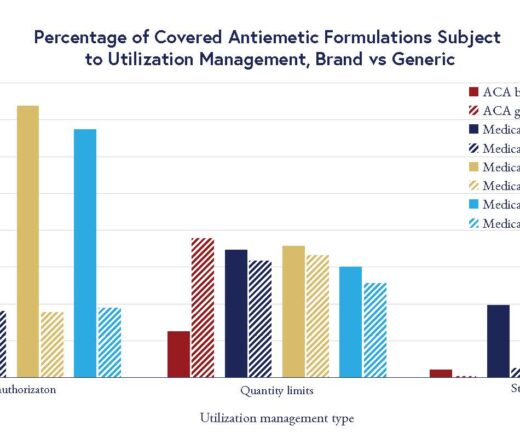
Insurers’ Utilization Management Tools Vary Widely on Anti-Nausea Drugs for Cancer
Chart of the Day: LDI Researchers Report Major Coverage Differences Across ACA and Medicaid Plans, Affecting Access to Drugs That Treat Chemo-Related Nausea
News | Video
Insufficient diversity in clinical trials and other research cohorts is widely recognized as one of American health care’s greatest problems and one that continues to skew scientific data and conclusions in ways that disadvantage enormous numbers of people.
It’s a problem that has been the subject of endless national discussions, debate, investigations, analysis, and general wheel-spinning throughout the highest levels of the health care policy community.
For instance, a 2022 consensus study at the National Academies of Sciences, Engineering, and Medicine (NAM) that looked back over the past 30 years of effort to diversify clinical trials found that “progress has largely stalled on participation of racial and ethnic minority population groups. …An equitable clinical research enterprise would include trials and studies that match the demographics of the disease burden under study. However, we remain far from achieving this goal.”
A March 2022 article in Health Affairs detailed a postmortem on a five-year-long Food and Drug Administration (FDA) “action program” aimed at improving diversity and transparency in clinical trials for new drugs. The authors reported that they “failed to find evidence that the FDA action plan improved representation of Black trial participants.”

It is against this general background that in 2021, two closely affiliated University of Pennsylvania research centers — the Palliative and Advanced Illness Research Center (PAIR) and the Center for Health Incentives and Behavioral Economics (CHIBE) — launched their own effort to find ways to increase diversity within their organizations’ clinical trials and other research studies.
“Many events in 2020 and 2021 galvanized renewed energy within our organization around long-standing social injustices,” said PAIR Director and LDI Senior Fellow Scott Halpern, MD, PhD. “Many of our researchers and staff were actively looking for ways to respond and recognized the need for greater emphasis on justice and inclusion in our own research processes. We quickly realized that charging a group to lead the way in producing guidance for equitable research practices would enable us all to learn from them, and best accomplish our shared goals.”
This resulted in the creation of the Joint Research Practices (JRP) Working Group.
“The goal of the JRP was to identify best practices and produce guidelines for the incorporation of equity, inclusion, and access across the arc of the research process,” said Rachel Kohn, MD, MSCE, Co-Lead of the JRP and LDI Senior Fellow. “Initially, we reached out to peer institutions to see if anyone was working on something similar. But we found that even in places where there was a lot of work being done surrounding health equity and social justice, there was no group working on identifying the fundamental methodology and practices that could be used for making specific parts of the research process more diversified, equitable, and accessible by underrepresented populations.”
Kohn said additional extensive literature reviews “provided no overall guidelines as to how to perform equitable, inclusive, and accessible research throughout an entire research process.”
She is an Assistant Professor of Pulmonary, Allergy, and Critical Care at the Perelman School of Medicine and a core faculty member at PAIR. The other Co-Lead of the JRP is Jingsan Zhu, MS, MBA, Director of Data Analytics at CHIBE.

Quietly and out of public view over the last three years, the JRP has conducted the brainstorming, data gathering, analysis, and organization required to create a comprehensive system of guidelines and best practice documentation that has been tested within their own organizations’ research projects. The JRP is made up of staff members from PAIR and CHIBE who are all involved in managing various kinds of clinical trials, prospective cohorts, and incentive and behavioral economics research. Their voluntary work on the JRP occurred outside of their formal daily duties.
In February, the Journal of General Internal Medicine published their paper entitled, “Operationalizing Equity, Inclusion, and Access in Research Practice at a Large Academic Institution” detailing their new system for how to make clinical trials and other research processes more diverse, equitable, and just.
“It would be hard to overstate how much this group has accomplished in so little time,” said Halpern. “What’s even more inspiring is that all of the energy and productivity came from the JRP members’ hearts. It’s been inspiring to witness this volunteer, grassroots effort at work, and hardly a day goes by that we don’t newly incorporate some of their guidance into another of our studies.”
Kohn noted that the initial focus of the work on projects within PAIR and CHIBE is now expanding. “Our goal is to network and collaborate as widely as possible to disseminate this work to the broader research community both within Penn and externally across the country.”
The JRP guidelines and best practices documents focus on the major obstacles that make the recruitment and retention of subjects from underrepresented communities so difficult–language barriers, social disadvantage, money, and the personal trust that evolves out of eliminating these barriers effectively.
The JRP guidelines cover:
“It’s still common for many studies to specifically call for English speaking subjects only,” said Kohn. “This is highly problematic, particularly given the number of limited English proficiency (LEP) patients who live in our country and also in light of the enormous numbers of new immigrants who are arriving.”
Some of the JRP recommendations are heavily informed by considerations related to social determinants of health. For instance, the guidelines note the importance of staging study visits with subjects in close proximity to their homes to eliminate the need to travel, and to pay for travel when it is required. Similarly, they recommend paying for food, child care, and elder care that can be impediments to participating in a study.
Other recommendations call for the research project to be flexible about payment and include a variety of payment options relevant to the participants’ needs. The payment guideline’s sections include Ethnical Considerations; Equity Considerations; Research Risks and Benefits; Payment Methods and Timing; Size of Payment; Regulations and Governance; Planning and Administration; and References for further information.
The JRP guideline documents have been gathered into a downloadable “Toolkit” on both the PAIR and CHIBE websites.
In Addition, the JRP has created a consultation service called “Practicing Equitable Research and Knowledge Sharing (PERKS).” Already used by more than 30 Penn researchers, it enables a researcher to directly tap into JRP expertise about how a particular part of a research process might be made more diverse and equitable.
When asked what has been one of the more noteworthy insights she’s taken from this experience, Kohn said “I think clinicians are generally aware that past research may have been conducted in an inequitable or unjust way, but they are not necessarily aware or familiar with the nuanced research methodology that might contribute to bias or inequity today. As a busy clinician myself, I think we are all trying to glean the main takeaways from research and doing our best to interpret groundbreaking research so that we can apply it clinically into our practice. But the goals of diversity and justice really require us to slow down and reflect about some of the operational decisions that were made and what their downstream effects might be on health equity.”


Chart of the Day: LDI Researchers Report Major Coverage Differences Across ACA and Medicaid Plans, Affecting Access to Drugs That Treat Chemo-Related Nausea

A Penn LDI Virtual Panel Looks Ahead at New Possibilities

Insurers Avoid Counties With Small Populations and Poor Health but a New LDI Study Finds Limited Evidence of Anticompetitive Behavior

The Evidence Suggests a Ban on Ads May Not Be A Well-Targeted Solution

Study of Six Large Language Models Found Big Differences in Responses to Clinical Scenarios

A Major Federal Value-Based Purchasing Program Was Designed to Cut Hospital Readmissions. LDI Fellows Say the Incentives Are Too Small to Drive Real Change